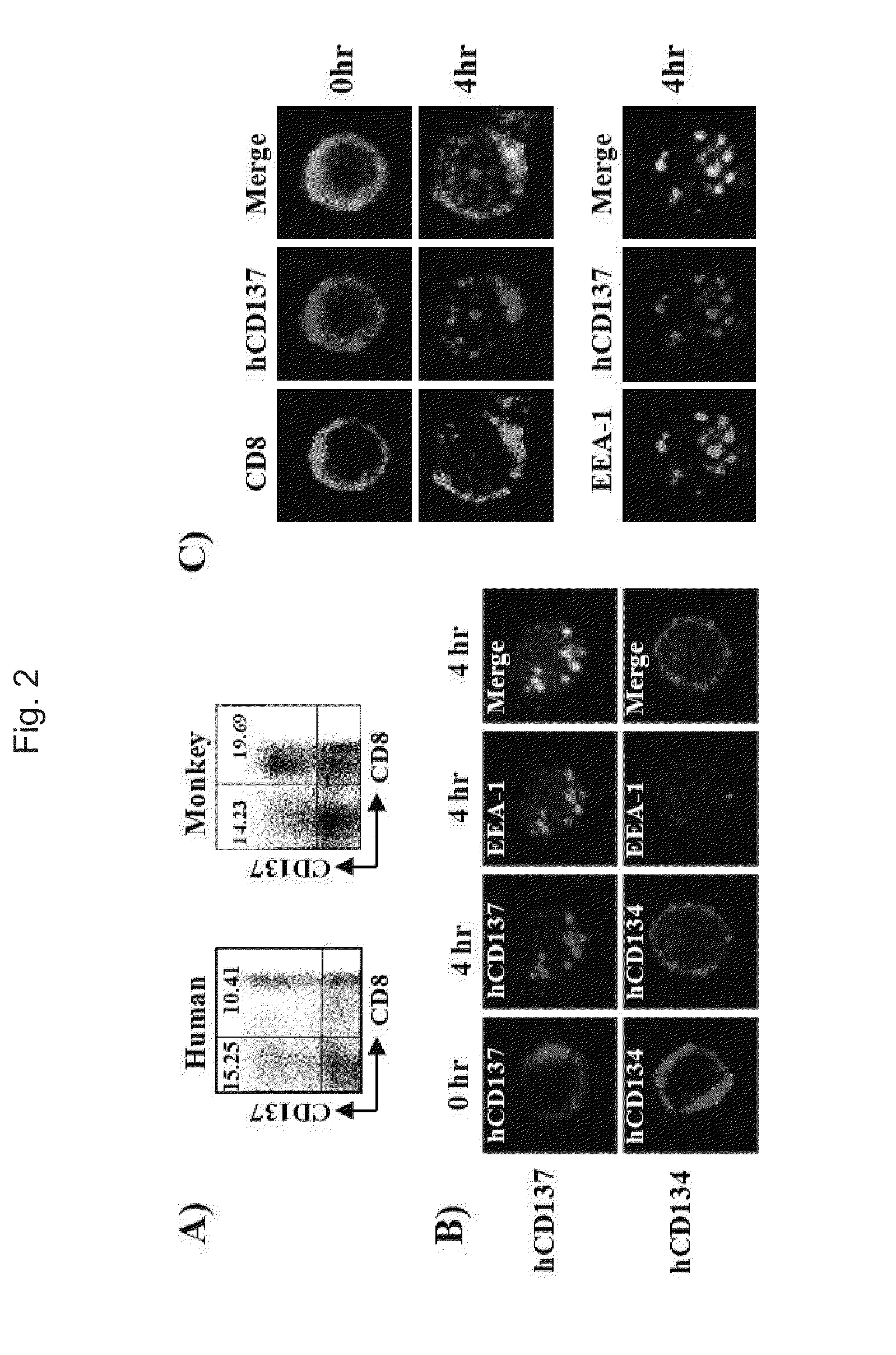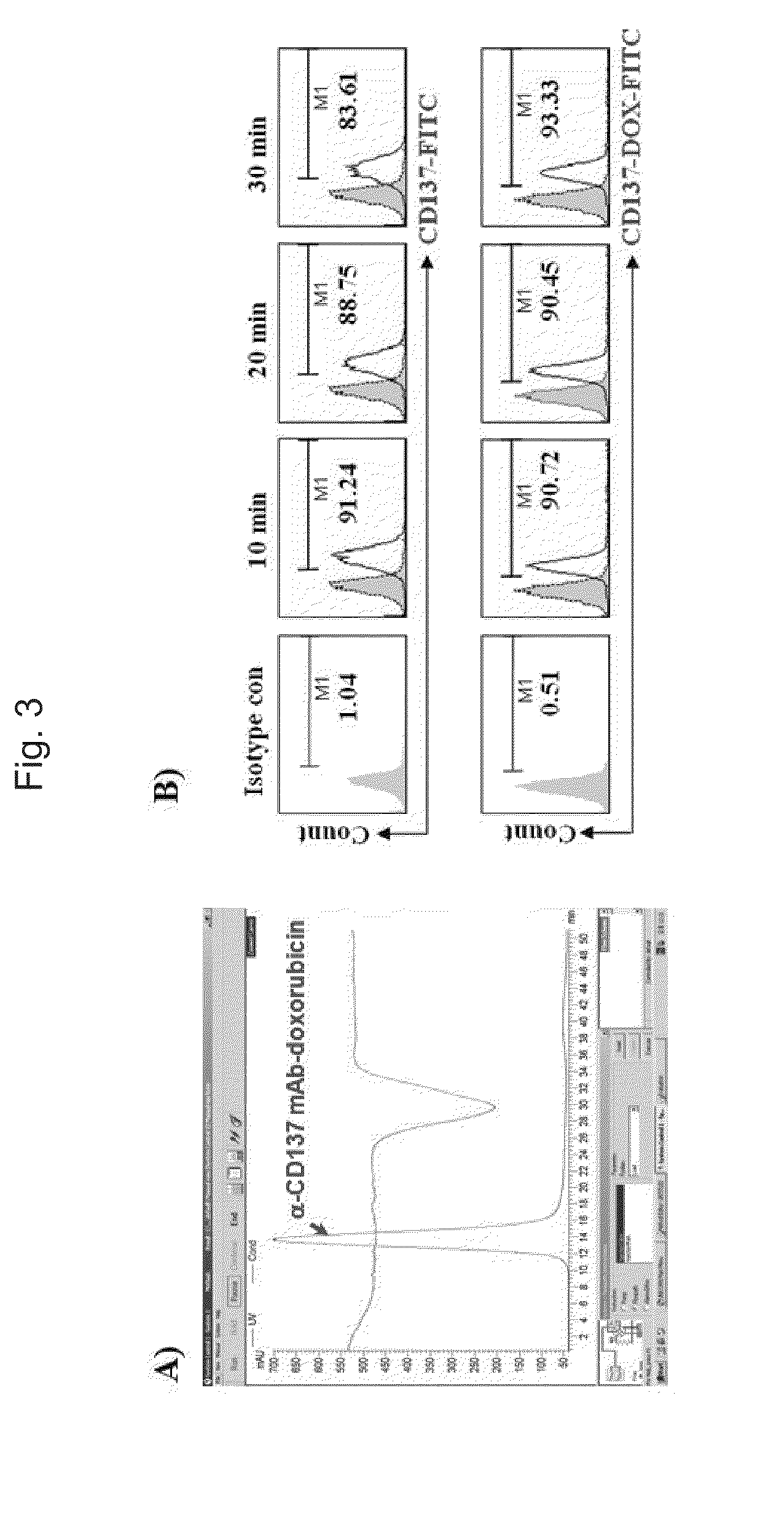Method for selective depletion of cd137 positive cells using Anti-cd137 antibody-toxin complex
an anti-cd137 antibody and complex technology, applied in the field of selective depletion of cd137 positive cells using an anti-cd137 antibodytoxin complex, can solve the problems of destroying native cells, tissues and organs, affecting normal immune cells, and eventually damaging normal cells, and achieves excellent suppression of cell proliferation.
- Summary
- Abstract
- Description
- Claims
- Application Information
AI Technical Summary
Benefits of technology
Problems solved by technology
Method used
Image
Examples
example 1
Determination of Endocytosis of CD137 And Anti-CD137 Antibody
[0089]First, the present inventors conducted the following experiment in order to determine whether or not an anti-CD137 antibody is effective in delivering a toxin, i.e., a cytotoxic drug, to target cells.
Determination of Internalization of Andti-CD137 Antibody Into Cell Lines
[0090]First, male mice (57BU6, BDF1) of 10 weeks of age purchased from Charles River Orient were used as experimental animals in the present invention, and were bred in a SPF (specific pathogens free) facility of Biomedical Research Center, Ulsan University. Also, an anti-mouse CD137 monoclonal antibody used in the following experiments was isolated and purified from ascites by a protein G column (Sigma-Aldrich, St. Louis, Mo.), the ascites being collected after the administration of hybridoma cells (3E1 and 3H3), a gift from Dr. Robert Mittler, Emory University, to nude mice, and then was purified. An anti-human CD137 monoclonal antibody (4B4, 4785)...
example 2
Synthesis of Anti-CD137 Antibody-Doxorubicin Complex
[0097]By confirming, through the experiment of Example 1, that an anti-CD137 antibody was internalized into cells by binding to CD137, a toxin to be delivered to CD137 positive cells was selected to synthesize a complex of the toxin and the anti-CD137 antibody. Doxorubicin, a kind of antitumor agent, was selected as the toxin, and a complex of an anti-CD137 antibody (clone: 3H3, 3E1) and doxorubicin was prepared by Peptron (Daejeon, Korea). First, MPBH and doxorubicin were added at a ratio of 1:10 to DMSO containing sodium sulfate, reacted under 50° C. for 30 minutes, and centrifugated to remove the sodium sulfate. After that, precipitates were produced by ether, and freeze-dried to obtain activated doxorubicin. Next, the anti-CD137 antibody was reduced to bind the activated doxorubicin to the anti-CD137 antibody. That is, 16 mg of anti-CD137 antibody in 1 ml of 40 mM DTT was partially reduced with 0.1M sodium phosphate containing ...
example 3
Measurement of Activation of Cell Apoptosis And Proliferation In Vitro By Anti-CD137 Antibody-Doxorubicin Complex
Measurement of Activation of Cell Apoptosis By Anti-CD137 Antibody-Doxorubicin Complex
[0099]Lymphocytes isolated from spleen and lymph nodes of normal mice and CD137-depleted mice were treated with an anti-CD3 antibody at a concentration of 0.2 μg / ml and cultured for 24 hours in cell culture fluid. After that, the cultured cells were collected and washed twice with PBS, and a small amount of cells (1×105 cells) were harvested and fluorescence-stained with PE-anti-CD137 mAb and FITC-anti-CD8 mAb-FITC or FITC-anti-CD4 mAb under 4° C. for 30 minutes. After being stained, the cells were washed twice with PBS, and CD137 expression on CD4+ T cells and CD8+ T cells was detected by a flow cytometry (FACS caliber, BD). When CD137 expression was detected, the cultured cells (1×106 cells) were treated at each concentration with the anti-CD137 antibody and doxorubicin prepared in Exa...
PUM
| Property | Measurement | Unit |
|---|---|---|
| concentration | aaaaa | aaaaa |
| concentration | aaaaa | aaaaa |
| pH | aaaaa | aaaaa |
Abstract
Description
Claims
Application Information
 Login to View More
Login to View More - R&D
- Intellectual Property
- Life Sciences
- Materials
- Tech Scout
- Unparalleled Data Quality
- Higher Quality Content
- 60% Fewer Hallucinations
Browse by: Latest US Patents, China's latest patents, Technical Efficacy Thesaurus, Application Domain, Technology Topic, Popular Technical Reports.
© 2025 PatSnap. All rights reserved.Legal|Privacy policy|Modern Slavery Act Transparency Statement|Sitemap|About US| Contact US: help@patsnap.com



